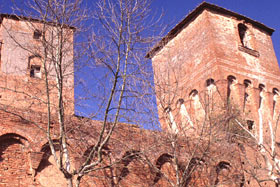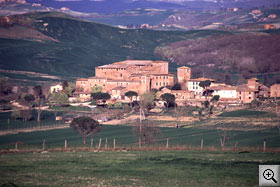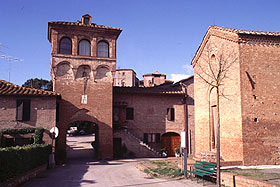Grancia di Cuna
The village of Cuna stands along the SS2 Cassia, a few hundred meters before entering in Monteroni d' Arbia. Exit from the Florence-Siena motorway at 'Siena Sud' then follow the indications for Buonconvento. Pass through Ponte a Tressa and continue on the old road without entering the new 4 lanes linkup motorway. Again few hundred meters and the huge Grancia di Cuna will appear on your right.
» More
Photos
From the 12th and 13th centuries the Hospice of Spedale of Santa Maria
della Scala of Siena took interest in the daily life of the hill community
of Cuna, in the Val d'Arbia near the important fortified water
mill of Monteroni d'Arbia. Here since the 1152 rose a hospice to
give shelter to the pilgrims and merchants traveling throughout the Francigena
Road. This hospice was property of the Torri Abbey. In the 13th century
the Hospice accumulated the main part of all its properties in the Val
d'Arbia and in 1295 Ristori Menghi di Giusto, rector of the Hospice, purchased
the small hill (poggiarello) known as 'di Cuna e Castelluccio'.
 |
| One of the towers of the inner walled enclosure and the machicolation of the curtain. |
Following the request of Ristoro was decided to build
a huge building at Cuna. His successor, Giovanni de' Tolomei, probably
began the construction of the grain farm in 1314, together with
the rebuilding of the church entitled to the Saints Giacomo and Cristoforo,
just outside the fortified walls main gate. In the 14th century, due to
political and military instability, in order to safeguard its own reserves
of cereals and grain, the Hospice was forced to fortify the farm by means
of restructuring operations which endowed it with distinctive features,
recurrent in the future typology of the granaries. The fortified granaries
of the Sienese countryside were called 'Grancia'. Cuna is still
today one of the best preserved of the whole Tuscany.
The complex was entirely build in red bricks. The original nucleus
can be recognized in the so called 'farm-fortress', a great and
high building with square shape and scarped walls located in the core
of the architectural complex, characterized by the compact structures
of the granaries and the two towers, endowed with machicoulis,
sited at the corners of the southern side. On this side is opened the
only gate that put in a little 'L' shaped inner courtyard. Here
we find a second gate and we can still notice part of the wall
walk. This entry was connected, through a hairpin-bend ramp [covered
with a splendid cross vault] that allowed to reach the higher floors also
with beasts of burden, with the inner storehouses. This formed
part of the first ring of walls dating back to the 14th century, quite
distinct from the second ring of the 16th century which encircled the
present day village and of which the main gate still remains. Later
on houses were built up against the walls filling in the space between
the ring of walls and the farm. The complex was sacked in 1554 by the
Austro-Hispanic armies. During the second half of the 16th century a roof
was added to the granary and the towers, overlapping the preexisting crenellation.
The addition of the imposing master homestead erected in between
the farm-fortress and the first ring of walls dates back to the 17th century.
| More Photos |
| Back to Homepage |
| Back to Castles Index |

